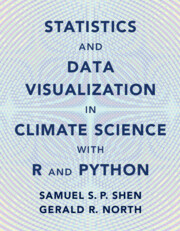75 results
Preface
-
- Book:
- Statistics and Data Visualization in Climate Science with R and Python
- Published online:
- 09 November 2023
- Print publication:
- 30 November 2023, pp xiii-xviii
-
- Chapter
- Export citation
7 - Introduction to Time Series
-
- Book:
- Statistics and Data Visualization in Climate Science with R and Python
- Published online:
- 09 November 2023
- Print publication:
- 30 November 2023, pp 243-286
-
- Chapter
- Export citation
2 - Elementary Probability and Statistics
-
- Book:
- Statistics and Data Visualization in Climate Science with R and Python
- Published online:
- 09 November 2023
- Print publication:
- 30 November 2023, pp 35-72
-
- Chapter
- Export citation
3 - Estimation and Decision-Making
-
- Book:
- Statistics and Data Visualization in Climate Science with R and Python
- Published online:
- 09 November 2023
- Print publication:
- 30 November 2023, pp 73-120
-
- Chapter
- Export citation
8 - Spectral Analysis of Time Series
-
- Book:
- Statistics and Data Visualization in Climate Science with R and Python
- Published online:
- 09 November 2023
- Print publication:
- 30 November 2023, pp 287-328
-
- Chapter
- Export citation
6 - Covariance Matrices, EOFs, and PCs
-
- Book:
- Statistics and Data Visualization in Climate Science with R and Python
- Published online:
- 09 November 2023
- Print publication:
- 30 November 2023, pp 200-242
-
- Chapter
- Export citation
Acknowledgments
-
- Book:
- Statistics and Data Visualization in Climate Science with R and Python
- Published online:
- 09 November 2023
- Print publication:
- 30 November 2023, pp xix-xix
-
- Chapter
- Export citation
1 - Basics of Climate Data Arrays, Statistics, and Visualization
-
- Book:
- Statistics and Data Visualization in Climate Science with R and Python
- Published online:
- 09 November 2023
- Print publication:
- 30 November 2023, pp 1-34
-
- Chapter
-
- You have access
- Export citation
Frontmatter
-
- Book:
- Statistics and Data Visualization in Climate Science with R and Python
- Published online:
- 09 November 2023
- Print publication:
- 30 November 2023, pp i-iv
-
- Chapter
- Export citation
5 - Matrices for Climate Data
-
- Book:
- Statistics and Data Visualization in Climate Science with R and Python
- Published online:
- 09 November 2023
- Print publication:
- 30 November 2023, pp 165-199
-
- Chapter
-
- You have access
- Export citation
4 - Regression Models and Methods
-
- Book:
- Statistics and Data Visualization in Climate Science with R and Python
- Published online:
- 09 November 2023
- Print publication:
- 30 November 2023, pp 121-164
-
- Chapter
- Export citation
Contents
-
- Book:
- Statistics and Data Visualization in Climate Science with R and Python
- Published online:
- 09 November 2023
- Print publication:
- 30 November 2023, pp vii-xii
-
- Chapter
- Export citation
9 - Introduction to Machine Learning
-
- Book:
- Statistics and Data Visualization in Climate Science with R and Python
- Published online:
- 09 November 2023
- Print publication:
- 30 November 2023, pp 329-386
-
- Chapter
- Export citation
How to Use This Book
-
- Book:
- Statistics and Data Visualization in Climate Science with R and Python
- Published online:
- 09 November 2023
- Print publication:
- 30 November 2023, pp xx-xxii
-
- Chapter
- Export citation
Dedication
-
- Book:
- Statistics and Data Visualization in Climate Science with R and Python
- Published online:
- 09 November 2023
- Print publication:
- 30 November 2023, pp v-vi
-
- Chapter
- Export citation
Index
-
- Book:
- Statistics and Data Visualization in Climate Science with R and Python
- Published online:
- 09 November 2023
- Print publication:
- 30 November 2023, pp 387-392
-
- Chapter
- Export citation

Statistics and Data Visualization in Climate Science with R and Python
-
- Published online:
- 09 November 2023
- Print publication:
- 30 November 2023
Challenges and strategies for recruitment of minorities to clinical research and trials
-
- Journal:
- Journal of Clinical and Translational Science / Volume 7 / Issue 1 / 2023
- Published online by Cambridge University Press:
- 13 June 2023, e154
-
- Article
-
- You have access
- Open access
- HTML
- Export citation
S47.04 Psychopathology following brain injury; Impact on return to work
-
- Journal:
- European Psychiatry / Volume 15 / Issue S2 / October 2000
- Published online by Cambridge University Press:
- 16 April 2020, p. 309s
-
- Article
-
- You have access
- Export citation
Correlative Imaging and Bio-inspiration: Multi-scale and Multi-modal Investigations of the Acorn Barnacle (Semibalanus balanoides)
-
- Journal:
- Microscopy and Microanalysis / Volume 24 / Issue S1 / August 2018
- Published online by Cambridge University Press:
- 01 August 2018, pp. 376-377
- Print publication:
- August 2018
-
- Article
-
- You have access
- Export citation



